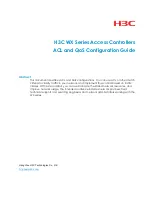
8
•
A virtual gateway IP address (a fictitious, unassigned IP address, such as 1.1.1.1, used by all Cisco
wireless LAN controller Layer 3 security and mobility managers).
•
A Cisco wireless LAN controller mobility group name, if required.
•
An 802.11 network name (SSID) for WLAN 1. This is the default SSID that the access points use
when they join with the controller.
•
Whether or not to allow static IP addresses from clients.
–
Yes is more convenient, but has lower security (session can be hijacked).
–
No is less convenient, but has higher security and works well for Windows XP devices.
•
RADIUS server IP address, communications port, and secret (if you are configuring a RADIUS
server).
•
The country code for this installation. Refer to the
Cisco Wireless LAN Controller Configuration
Guide
for country code information. This guide is available at cisco.com.
•
Status of the 802.11a, 802.11b, and 802.11g networks (enabled or disabled).
•
Status of radio resource management (RRM) (enabled or disabled).
Choosing a Physical Location
You can install the controller almost anywhere, but it is more secure and reliable if you install it in a
secure equipment room or wiring closet. For maximum reliability, mount the controller using the
following guidelines:
Warning
To prevent the system from overheating, do not operate it in an area that exceeds the
maximum recommended ambient temperature of:
104° F (40° C)
Statement 1047
Warning
To prevent airflow restriction, allow clearance around the ventilation openings to be at
least:
4-in (10.16 cm)
Statement 1076
Warning
Take care when connecting units to the supply circuit so that wiring is not overloaded.
Statement 1018
•
Make sure you can reach the controller and all cables attached to it.
•
Make sure that water or excessive moisture cannot get into the controller.









































